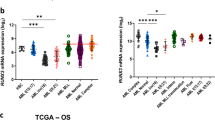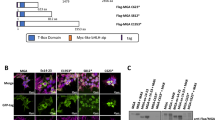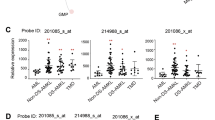Abstract
Ectopic expression of LIM-only protein 2 (LMO2) in T-cells, as a result of chromosomal translocations or retroviral insertion, plays an important role in the onset of T-cell leukemias. Two transcripts of LMO2 gene (LMO2-a and LMO2-b) have been reported to encode a same 158-amino-acid protein. We have previously reported a novel transcript of human LMO2 gene (LMO2-c) encoding a 151-amino-acid protein, and defined its promoter region. In the present study, we investigated the regulation of the LMO2-c expression and the functions of LMO2-c. We found that LMO2-c expression is regulated by the cooperation of two essential hematopoietic transcription factors GATA-1 and PU.1 in various hematopoietic cell lines, suggesting an important functional role for LMO2-c in the hematopoietic system. More importantly, we demonstrated that LMO2-c acts as an antagonist of LMO2-a/b binding to its partners, therefore blocking the transactivation of LMO2-a/b on its target genes. These findings provide novel evidence to the functions of LMO2 gene in the hematopoietic system and leukemia.
This is a preview of subscription content, access via your institution
Access options
Subscribe to this journal
Receive 12 print issues and online access
$259.00 per year
only $21.58 per issue
Buy this article
- Purchase on Springer Link
- Instant access to full article PDF
Prices may be subject to local taxes which are calculated during checkout








Similar content being viewed by others
Accession codes
References
Royer-Pokora B, Loos U, Ludwig W-D . TTG-2, a new gene encoding a cysteine-rich protein with the LIM motif, is overexpressed in acute T-cell leukaemia with the t(11:14)(p13:q11). Oncogene 1991; 6: 1887–1893.
Royer-Pokora B, Rogers M, Zhu TH, Schneider S, Loos U, Bolitz U . The TTG-2/RBTN2 T cell oncogene encodes two alternative transcripts from two promoters: the distal promoter is removed by most 11p13 translocations in acute T cell leukaemia's (T-ALL). Oncogene 1995; 10: 1353–1360.
Nam CH, Rabbitts TH . The role of LMO2 in development and in T cell leukemia after chromosomal translocation or retroviral insertion. Mol Ther 2006; 13: 15–25.
Ferrando AA, Neuberg DS, Staunton J, Loh ML, Huard C, Raimondi SC et al. Gene expression signatures define novel oncogenic pathways in T cell acute lymphoblastic leukemia. Cancer Cell 2002; 1: 75–87.
Warren AJ, Colledge WH, Carlton MB, Evans MJ, Smith AJ, Rabbitts TH . The oncogenic cysteine-rich LIM domain protein rbtn2 is essential for erythroid development. Cell 1994; 78: 45–57.
Visvader JE, Mao X, Fujiwara Y, Hahm K, Orkin SH . The LIM-domain binding protein Ldb1 and its partner LMO2 act as negative regulators of erythroid differentiation. Proc Natl Acad Sci USA 1997; 94: 13707–13712.
Yamada Y, Warren AJ, Dobson C, Forster A, Pannell R, Rabbitts TH . The T cell leukemia LIM protein Lmo2 is necessary for adult mouse hematopoiesis. Proc Natl Acad Sci USA 1998; 95: 3890–3895.
McCormack MP, Forster A, Drynan L, Pannell R, Rabbitts TH . The LMO2 T-cell oncogene is activated via chromosomal translocations or retroviral insertion during gene therapy but has no mandatory role in normal T-cell development. Mol Cell Biol 2003; 23: 9003–9013.
Bach I . The LIM domain: regulation by association. Mech Dev 2000; 91: 5–17.
Wadman IA, Osada H, Grutz GG, Agulnick AD, Westphal H, Forster A et al. The LIM-only protein Lmo2 is a bridging molecule assembling an erythroid, DNA-binding complex which includes the TAL1, E47, GATA-1 and Ldb1/NL1 proteins. EMBO 1997; 16: 3145–3157.
Ono Y, Fukuhara N, Yoshie O . TAL1 and LIM-only proteins synergistically induce retinaldehyde dehydrogenase 2 expression in T-cell acute lymphoblastic leukemia by acting as cofactors for GATA3. Mol Cell Biol 1998; 18: 6939–6950.
Anderson KP, Crable SC, Lingrel JB . Multiple proteins binding to a GATA-E box-GATA motif regulate the erythroid Krüppel-like factor (EKLF) gene. J Biol Chem 1998; 273: 14347–14354.
Lecuyer E, Herblot S, Saint-Denis M, Martin R, Begley CG, Porcher C et al. The SCL complex regulates c-kit expression in hematopoietic cells through functional interaction with Sp1. Blood 2002; 100: 2430–2440.
Xu Z, Huang S, Chang LS, Agulnick AD, Brandt SJ . Identification of a TAL1 target gene reveals a positive role for the LIM domain-binding protein Ldb1 in erythroid gene expression and differentiation. Mol Cell Biol 2003; 23: 7585–7599.
Anguita E, Hughes J, Heyworth C, Blobel GA, Wood WG, Higgs DR . Globin gene activation during haemopoiesis is driven by protein complexes nucleated by GATA-1 and GATA-2. EMBO J 2004; 23: 2841–2852.
Lahlil R, Lecuyer E, Herblot S, Hoang T . SCL assembles a multifactorial complex that determines glycophorin A expression. Mol Cell Biol 2004; 24: 1439–1452.
Zhu TH, Qin G, Royer-Pokora B . A novel post-transcriptional splicing form of the acute T cell leukemia proto-oncogene Lmo2. Sci China (Ser C-Life Sci) 2001; 44: 561–569.
Pruess MM, Drechsler M, Royer-Pokora B . Promoter 1 of LMO2, a master gene for hematopoiesis, is regulated by the erythroid specific transcription factor GATA1. Gene Funct Dis 2000; 2: 87–94.
Landry JR, Kinston S, Knezevic K, Donaldson IJ, Green AR, Gottgens B . Fli1, Elf1, and Ets1 regulate the proximal promoter of the LMO2 gene in endothelial cells. Blood 2005; 106: 2680–2687.
Nerlov C, Querfurth E, Kulessa H, Graf T . GATA-1 interacts with the myeloid PU.1 transcription factor and represses PU.1-dependent transcription. Blood 2000; 95: 2543–2551.
Zhang P, Behre G, Pan J, Iwama A, Wara-Aswapati N, Rodomska HS et al. Negative cross-talk between hematopoietic regulators: GATA proteins repress PU.1. Proc Natl Acad Sci USA 1999; 96: 8705–8710.
Zhang P, Zhang X, Iwama A, Yu C, Smith KA, Mueller BU et al. PU.1 inhibits GATA-1 function and erythroid differentiation by blocking GATA-1 DNA binding. Blood 2000; 96: 2641–2648.
Stopka T, Amanatullah DF, Papetti M, Skoultchi AI . PU.1 inhibits the erythroid program by binding to GATA-1 on DNA and creating a repressive chromatin structure. EMBO J 2005; 24: 3712–3723.
Benchabane H, Wrana JL . GATA- and Smad1-dependent enhancers in the Smad7 gene differentially interpret bone morphogenetic protein concentrations. Mol Cell Biol 2003; 23: 6646–6661.
Luo B, Heard AD, Lodish HF . Small interfering RNA production by enzymatic engineering of DNA (SPEED). Proc Natl Acad Sci USA 2004; 101: 5494–5499.
Terano T, Zhong Y, Toyokuni S, Hiai H, Yamada Y . Transcriptional control of fetal liver hematopoiesis: dominant negative effect of the overexpression of the LIM domain mutants of LMO2. Exp Hematol 2005; 33: 641–651.
Mead PE, Deconinck AE, Huber TL, Orkin SH, Zon LI . Primitive erythropoiesis in the Xenopus embryo: the synergistic role of LMO-2, SCL and GATA-binding proteins. Development 2001; 128: 2301–2308.
Gering M, Yamada Y, Rabbitts TH, Patient RK . Lmo2 and Scl/Tal1 convert non-axial mesoderm into haemangioblasts which differentiate into endothelial cells in the absence of Gata1. Development 2003; 130: 6187–6199.
Graf T . Differentiation plasticity of hematopoietic cells. Blood 2002; 99: 3089–3101.
Rekhtman N, Choe KS, Matushansky I, Murray S, Stopka T, Skoultchi AI . PU.1 and pRB interact and cooperate to repress GATA-1 and block erythroid differentiation. Mol Cell Biol 2003; 23: 7460–7474.
Harrison CJ, Foroni L . Cytogenetics and molecular genetics of acute lymphoblastic leukemia. Rev Clin Exp Hematol 2002; 62: 91–113.
Hatano M, Roberts CWM, Minden M, Crist WM, Korsmeyer SJ . Deregulation of a homeobox gene, HOX11, by the t(10;14) in T-cell leukemia. Science 1991; 253: 70–72.
Chen Q, Cheng JT, Tsai LH, Schneider N, Buchanan G, Carroll A et al. The tal gene undergoes chromosome translocation in T cell leukemia and potentially encodes a helix–loop–helix protein. EMBO J 1990; 9: 415–424.
Xia Y, Brown L, Yang CY-C, Tsai JT, Siciliano MJ, Espirosa R et al. TAL2, a helix–loop–helix gene activated by the (7;9)(q34;q32) translocation in human T-cell leukemia. Proc Natl Acad Sci USA 1991; 88: 11416–11420.
McGuire EA, Hockett RD, Pollock KM, Bartholdi MF, O'Brien SO, Korsmeyer SJ . The t(11;14)(p15;q11) in a T-cell acute lymphoblastic leukemia cell line activates multiple transcripts, including Ttg-1, a gene encoding a potential zinc finger protein. Mol Cell Biol 1989; 9: 2124–2132.
Mellentin JD, Smith SD, Cleary ML . lyl-1, a novel gene altered by chromosomal translocation in T cell leukemia, codes for a protein with a helix–loop–helix DNA binding motif. Cell 1989; 58: 77–83.
Hacein-Bey-Abina A, Von Kalle C, Schmidt M, McCormack MP, Wulffraat N, Leboulch P et al. LMO2-associated clonal T cell proliferation in two patients after gene therapy for SCID-X1. Science 2003; 302: 415–419.
Schmidt M, Hacein-Bey-Abina S, Wissler M, Carlier F, Lim A, Prinz C et al. Clonal evidence for the transduction of CD34+ cells with lymphomyeloid differentiation potential and self-renewal capacity in the SCID-X1 gene therapy trial. Blood 2005; 105: 2699–2706.
Choe KS, Radparvar F, Matushansky I, Rekhtman N, Han X, Skoultchi AI . Reversal of tumorigenicity and the block to differentiation in erythroleukemia cells by GATA-1. Cancer Res 2003; 63: 6363–6369.
Acknowledgements
This work was supported by a grant from The Natural Sciences Foundation of Tianjin City (No. 05YFJMJC01800).
Author information
Authors and Affiliations
Corresponding author
Additional information
Supplementary Information accompanies the paper on the Leukemia website (http://www.nature.com/leu)
Rights and permissions
About this article
Cite this article
Wang, Q., Zhang, M., Wang, X. et al. A novel transcript of the LMO2 gene, LMO2-c, is regulated by GATA-1 and PU.1 and encodes an antagonist of LMO2. Leukemia 21, 1015–1025 (2007). https://doi.org/10.1038/sj.leu.2404644
Received:
Revised:
Accepted:
Published:
Issue Date:
DOI: https://doi.org/10.1038/sj.leu.2404644
Keywords
This article is cited by
-
Homo-binding character of LMO2 isoforms and their both synergic and antagonistic functions in regulating hematopoietic-related target genes
Journal of Biomedical Science (2010)
-
miR-223 and miR-142 attenuate hematopoietic cell proliferation, and miR-223 positively regulates miR-142 through LMO2 isoforms and CEBP-β
Cell Research (2010)



